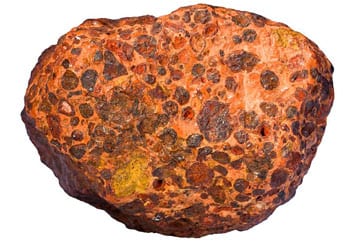Fè chwa lang:
Aliminyom se eleman nan metal ki pi komen yo te jwenn sou late, totalize sou 8% kwout late. Sepandan, aluminum as an element is reactive and, se poutèt sa, does not occur naturally – it needs to be refined to produce aluminum metal. Prensipal materyel la komanse pou raffinage aliminyom se Boksit, sous prensipal komesyal mondyal la nan aliminyom. Bauxite is a sedimentary rock and consists mostly of the aluminum minerals gibbsite (Al(o)3), maren (γ-AlO(o)), e dyaspora (α-AlO(o)), e anjeneral melanje ak de oksid fe yo goethite ak emaye, the aluminum clay mineral kaolinite and small amounts of anatase (TiO2) e/oswa ilmenite (FeTiO3).

Depo Boksit yo gaye atrave lemond, sitou rive nan rejyon twopikal oswa subtropical. Malgre ke pwouve rezev nan Boksit yo espere pou denye pou anpil ane, bon jan kalite a nan rezev yo ki ka ekonomikman jwenn akse se dekline. For refiners who are in the business of bauxite processing to make alumina and, eventually, aluminum metal, sa a se yon defi ak tou de enplikasyon finansye ak anviwonman.
The process of refining metallurgical bauxite into alumina involves the following inputs:
Outputs sa yo pwodwi:

Pwosesis chimik ki pi lajman itilize nan raffinage Boksit nan alumina, pwosesis Bayer la, enplike nan Al2O3 soti nan woch la Boksit ak soda rilan (Naoh) nan tanperati ki wo ak presyon. The Al2O3 fraction of the bauxite is dissolved into a solution, which is later precipitated out as alumina. Sepandan, high-grade bauxite contains up to 60% Al2O3, and many operating bauxite deposits are well below this, occasionally as low as 30-40% Al2O3. Because the desired product is a high-purity Al2O3, the remaining oxides in the bauxite (Fe2O3, Sio2, TiO2, Organic material) are separated from the Al2O3 and rejected as alumina refinery resides (ARR) or red mud. In general, the lower the quality of the bauxite (sa vle di, lower Al2O3 content), the more red mud is generated per ton of alumina product. epi tou, even some Al2O3-bearing minerals, notably kaolinite, produce undesirable side reactions during the refining process and lead to an increase in red mud generation, as well as a loss of expensive caustic soda chemical, a high variable cost in the bauxite refining process.
Red mud, or ARR, represents a large and on-going challenge for the aluminum industry. Red mud contains significant residual caustic chemical leftover from the refining process and is highly alkaline, often with a pH of 10 - 13. It is generated in large volumes worldwide – according to the USGS, estimated global alumina production was 121 million tons in 2016. This likely resulted in more than 150 million tons of red mud generated during the same period. Despite ongoing research, red mud currently has few commercially viable paths to beneficial re-use. It is estimated that very little red mud is beneficially re-used worldwide. Olye de sa, the red mud is pumped from the alumina refinery into storage impoundments or landfills, where it is stored and monitored at a high cost.
The loss of expensive caustic soda (Naoh) ak jenerasyon an nan labou wouj yo tou de ki gen rapo ak bon jan kalite a nan Boksit yo itilize nan pwosesis la raffinage. In general, pi ba a Al2O3 kontni nan Boksit la, pi gwo volim labou wouj ki pral pwodwi, kom faz ki pa Al2O3 yo rejte kom labou wouj. epi tou, pi wo a kaolinite oswa reyaktif silica kontni nan Boksit la, yo pral pwodwi plis labou wouj. The reactive silica content not only increases the volume of red mud but also consumes caustic soda reagent and reduces the yield of Al2O3 recovered from the bauxite. Se poutet sa, both an economic and environmental argument must be made to improve the quality of bauxite prior to refining.
The STET dry separation process offers bauxite producers or bauxite refiners an opportunity to perform pre-bayer-process upgrading of bauxite ore to improve the quality. This approach has many benefits:
An rezime, pwosesis sek ak separate STET a ofri opotinite pou jenere vale pou pwodikte Boksit ak pirifikate. Pre-pwosesis la nan Boksit anvan raffinage ap redwi depans chimik, pi ba volim labou wouj la pwodwi ak minimize pwosesis ove san.
Referans: